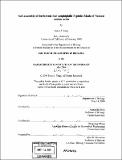| dc.contributor.advisor | Alexander Rich and Shuguang Zhang. | en_US |
| dc.contributor.author | Yang, Steve J., 1976- | en_US |
| dc.contributor.other | Massachusetts Institute of Technology. Dept. of Biology. | en_US |
| dc.date.accessioned | 2006-03-29T18:27:44Z | |
| dc.date.available | 2006-03-29T18:27:44Z | |
| dc.date.copyright | 2004 | en_US |
| dc.date.issued | 2004 | en_US |
| dc.identifier.uri | http://hdl.handle.net/1721.1/32251 | |
| dc.description | Thesis (Ph. D.)--Massachusetts Institute of Technology, Dept. of Biology, 2004. | en_US |
| dc.description | Includes bibliographical references. | en_US |
| dc.description.abstract | Progress in biology has always been linked to the development of novel materials and techniques such as agar for bacterial culture, agarose for nucleic acid gel electrophoresis to new fluorescent molecules for microscopy. Invention of new tools is necessary for future solutions to biological problems. One such important problem is the study of membrane proteins, most of which are not amenable to biochemical or structural studies due to their inherent insolubility and instability outside of the natural cellular membrane. Here we describe the development and behavior of a new class of amphiphilic molecules made of peptides, which may be used for solubilization and stabilization of membrane proteins. The peptides have a hydrophilic head group and a hydrophobic tail and self-assemble in aqueous solution to form tubes, vesicles and membranes. Each monomer is around 7 or 8 amino acids in length, but longer or shorter molecules can be very easily synthesized using standard peptide synthesis protocols. Two general motifs of amphiphilic peptides were designed based on the identity of the head group: one has a phosphoserine and the other, aspartic acid. For the phosphoserine peptide, the self-assembling behavior was investigated at different pH, salt concentrations and temperature. The critical aggregation concentrations of both motifs were also investigated. It was discovered that after a certain concentration, the peptides aggregated into different structures, and this self-assembling behavior is dependent on the environmental conditions. | en_US |
| dc.description.statementofresponsibility | by Steve J. Yang. | en_US |
| dc.format.extent | 227, [16] p. | en_US |
| dc.format.extent | 10140231 bytes | |
| dc.format.extent | 10136386 bytes | |
| dc.format.mimetype | application/pdf | |
| dc.format.mimetype | application/pdf | |
| dc.language.iso | eng | en_US |
| dc.publisher | Massachusetts Institute of Technology | en_US |
| dc.rights | M.I.T. theses are protected by copyright. They may be viewed from this source for any purpose, but reproduction or distribution in any format is prohibited without written permission. See provided URL for inquiries about permission. | en_US |
| dc.rights.uri | http://dspace.mit.edu/handle/1721.1/7582 | |
| dc.subject | Biology. | en_US |
| dc.title | Self-assembly of aurfactant-like amphiphilic peptides made of natural amino acids | en_US |
| dc.type | Thesis | en_US |
| dc.description.degree | Ph.D. | en_US |
| dc.contributor.department | Massachusetts Institute of Technology. Department of Biology | |
| dc.identifier.oclc | 56023381 | en_US |
